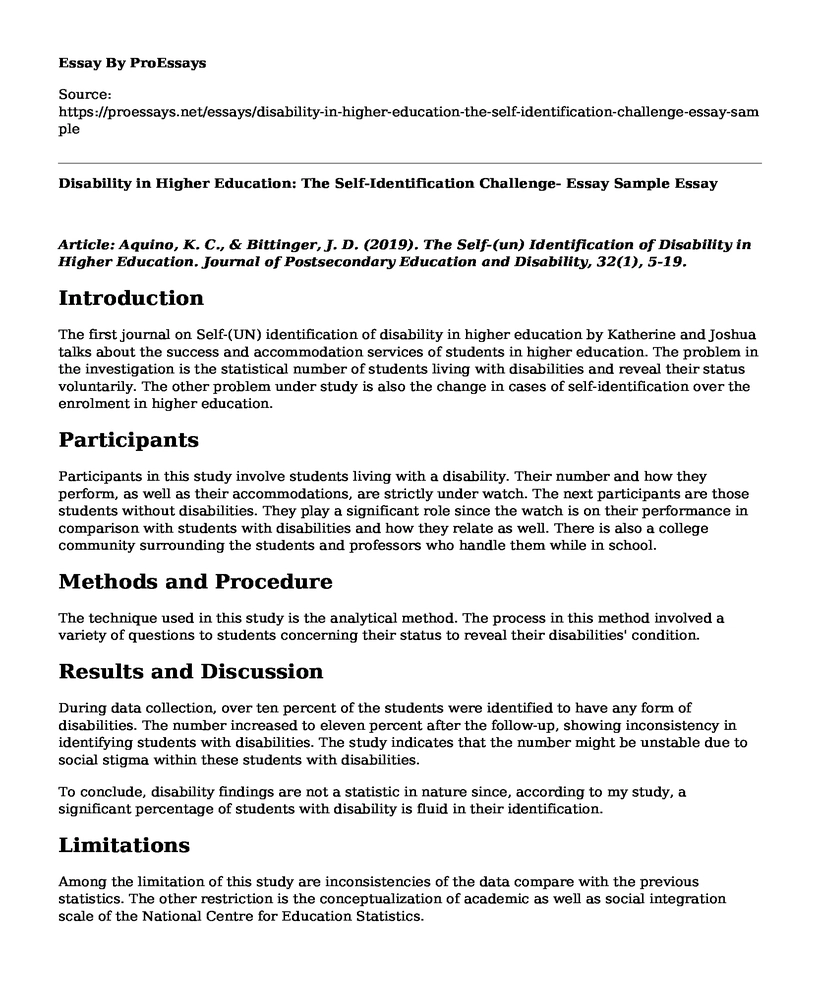Article: Aquino, K. C., & Bittinger, J. D. (2019). The Self-(un) Identification of Disability in Higher Education. Journal of Postsecondary Education and Disability, 32(1), 5-19.
Introduction
The first journal on Self-(UN) identification of disability in higher education by Katherine and Joshua talks about the success and accommodation services of students in higher education. The problem in the investigation is the statistical number of students living with disabilities and reveal their status voluntarily. The other problem under study is also the change in cases of self-identification over the enrolment in higher education.
Participants
Participants in this study involve students living with a disability. Their number and how they perform, as well as their accommodations, are strictly under watch. The next participants are those students without disabilities. They play a significant role since the watch is on their performance in comparison with students with disabilities and how they relate as well. There is also a college community surrounding the students and professors who handle them while in school.
Methods and Procedure
The technique used in this study is the analytical method. The process in this method involved a variety of questions to students concerning their status to reveal their disabilities' condition.
Results and Discussion
During data collection, over ten percent of the students were identified to have any form of disabilities. The number increased to eleven percent after the follow-up, showing inconsistency in identifying students with disabilities. The study indicates that the number might be unstable due to social stigma within these students with disabilities.
To conclude, disability findings are not a statistic in nature since, according to my study, a significant percentage of students with disability is fluid in their identification.
Limitations
Among the limitation of this study are inconsistencies of the data compare with the previous statistics. The other restriction is the conceptualization of academic as well as social integration scale of the National Centre for Education Statistics.
Article: Cole, E. V., & Cawthon, S. W. (2015). Self-Disclosure Decisions of University Students with Learning Disabilities. Journal of Postsecondary Education and Disability, 28(2), 163-179.
Introduction
The second review involves a journal by Emma and Stephanie on self -disclosure decisions on students living with disabilities. The problem in the investigation within the study is the psychological difference factors between students living with disabilities who disclose and those who do not.
Participants
Participants in this study include students living with disabilities who disclose and those who don't disclose their disability condition, classmates, without limitations, and university staff, including professors.
Methods and Procedure
The process involved an interview for the students admitted to the university for the first time. It included a ten percent rule, that is to say, students who appeared in the top ten in their class could gain automatic acceptance to the state university. The other procedure also involved questions of the study survey concerning the diagnosis of a student's condition. The next method is screening students using educational psychology research pool screener. Qualtrics review is also among the procedure used; it involved information on the level of disclosure and usage of accommodation.
Results and Discussion
Results fall into the category of quantitative and qualitative results. Findings also showed that the choice of the student not disclosing his or her status could be affected by experience with the classmates. Lastly, many codes identified as an essential theme in student living with disability decision relied on the experience with the professor. To conclude, a significant number of factors can make one not to disclose his or her disability status
Limitation
Limitations here include a low number of participants in a quantitative study. The next disadvantage is that qualitative participants presented a convenience sample that could not match the disclosure group. Finally is the use of chosen self-determination and self-disclosure scale.
Cite this page
Disability in Higher Education: The Self-Identification Challenge- Essay Sample. (2023, Feb 27). Retrieved from https://proessays.net/essays/disability-in-higher-education-the-self-identification-challenge-essay-sample
If you are the original author of this essay and no longer wish to have it published on the ProEssays website, please click below to request its removal:
- Research Paper on Effective Ways to Prevent Cancer
- Otitis Media Paper Example
- MORAL Model Essay Example
- Research Paper on Unhealthy Eating Is a Behavioural Problem Among Truck Drivers
- Mastery Learning: Unlocking Students' Potential Beyond Grades - Research Paper
- Essay on Visiting Hours in ICU: Limitations on Family Care and Life-Critical Decisions
- Essay on My Journey as a Nurse: Childhood Inspiration and Beyond







